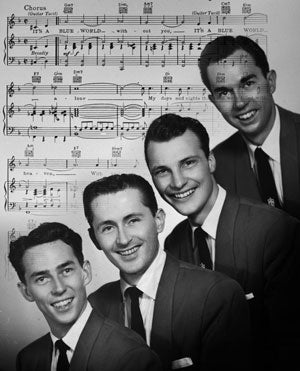Bob Flanigan: Key member of the close-harmony vocal group the Four Freshmen

Your support helps us to tell the story
From reproductive rights to climate change to Big Tech, The Independent is on the ground when the story is developing. Whether it's investigating the financials of Elon Musk's pro-Trump PAC or producing our latest documentary, 'The A Word', which shines a light on the American women fighting for reproductive rights, we know how important it is to parse out the facts from the messaging.
At such a critical moment in US history, we need reporters on the ground. Your donation allows us to keep sending journalists to speak to both sides of the story.
The Independent is trusted by Americans across the entire political spectrum. And unlike many other quality news outlets, we choose not to lock Americans out of our reporting and analysis with paywalls. We believe quality journalism should be available to everyone, paid for by those who can afford it.
Your support makes all the difference.With his tenor voice and exciting trombone playing, Bob Flanigan was a key part and long-serving member of the Four Freshmen.
The group – essentially a sophisticated barbershop quartet – survived the ructions and revolutions in popular music and still draws audiences today, more than 60 years after it was founded. Close-harmony groups, from the Boswell Sisters in the 1930s to the Andrews Sisters in the '40s, seemed to have limited shelf life. But against the odds the Four Freshmen honed and polished the formula and, by each playing musical instruments, gave it new and apparently immortal variety. The current version of the quartet is the 22nd.
Flanigan wasn't the instigator of the group. When, after finishing his army service in 1948, he enrolled at Butler University, he joined a barbershop quartet started by Hal Kratzsch, who had enlisted two of Flanigan's cousins, Ross and Don Barbour, both students at the University. In Hal's Harmonizers, as they were known, Flanigan, a tenor, took the lead parts and played trombone and double bass, while other singers played trumpet, guitar and drums. So, unusually, the group was self-sufficient at providing its own accompaniment.
To the dismay of their parents, the four singers did not graduate, leaving university to become professional musicians. Their skills developedearly and they were supported by musicians like Woody Herman and Dizzy Gillespie, who were both admirers. But it wasn't until they encountered Stan Kenton that they really became successful.
Although often regarded as a pop group, this was basically a jazzquartet. Flanigan in particular was a good jazz trombonist, his style rooted in those of Kai Winding and MiltBernhart of the Stan Kenton band. And the singers admired the Kenton band's precision and drew elements of his band's arrangements into their own repertoire.
"We all think in instrumental terms," said Flanigan. "I think of singing lead as I would play it on trombone sitting in the Kenton trombone section. When we started we were all Kenton fans and everybody who's been in the group since then has been a Kenton fan."
In 1950 Kenton heard one of the Freshmen's concerts in Dayton, Ohio and was so impressed that he enthusiastically recommended the four to his record company, Capitol. Their first big hit came in 1952 with "It's a Blue World", followed by "Day By Day" and "Graduation Day"; they also sold a substantial number of albums.
By the time the quartet toured with Kenton and June Christy and recorded the famous Road Show album in 1959, they had, like Stan himself, become world-weary. The young Kenton arranger Bill Mathieu recalled life on the road: "More than anything else I saw booze. Christy, Bob Flanigan and Stan were officers of some kind of drinking club, and a fearful amount of alcohol was consumed. Each night Stan drank his quart of scotch."
The drinking and the touring inevitably led to marital problems. In November 1962 Down Beat reported that Kenton had become a director of the newly formed Divorced Men's Club. "He had already become executive vice-president of NAGMA (Never Again Get Married Association), co-created with president Bob Flanigan of the Four Freshmen."
By 1963 Flanigan was happily married to his second wife. And, despite the alcohol, the Freshmen were at their best when they sang in company with Kenton and Christy.
Their quality ensured that theFour Freshmen were never usurped, and they influenced all the vocal groups who came after them, including the Double Six of Paris, Manhattan Transfer, the Hi-Los andthe Beach Boys. Flanigan continuedto sing with the Freshmen until 1992 then stayed on as the group's manager for another five years. He kept a guiding hand until his death. Even the missed graduation was adjusted when Butler University awarded him an honorary doctorate in 2008.
Robert Lee Flanigan, singer and bandleader: born Greencastle, Indiana 22 August 1926; married firstly (marriage dissolved; one son, one daughter), 1963 Mary Scott (one son, three daughters); died Las Vegas 15 May 2011.
Join our commenting forum
Join thought-provoking conversations, follow other Independent readers and see their replies
Comments